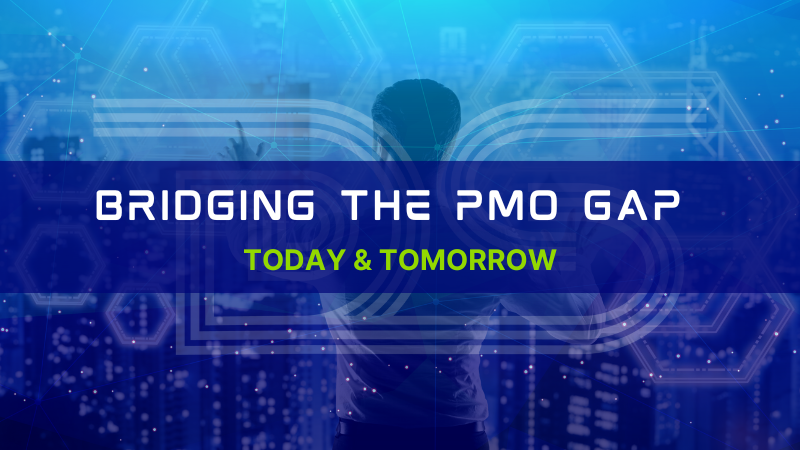
Bridging the PMO Gap – Today & Tomorrow
A Project Management Office (PMO) is a group or department within an organization that defines and maintains project management standards. It provides project management guidelines and standards. In addition, it aids in developing measurable objectives that align with the organization’s overall vision and ensure that all targets are met. PMO will also be referred to as a program or project portfolio management office, depending on the project/program/portfolio.
The Project/Program/Portfolio office has undergone a paradigm shift during this COVID-19. This shift has also paved the way for innovative ways of its operations and leads us to the question of revisiting gaps PMOs have from the context between where we are today and how the future holds for the PMO. Project managers/portfolio managers need to embrace today’s PMO situation and be ready for transformation in the days ahead. There could be challenges and opportunities that need prioritizing. This article helps to envisage the gaps between PMOs of today and PMOs of the future.
PMO Types
PMOs are based on their degree of control and influence on projects. Of the many types, there are three distinct types of PMO.
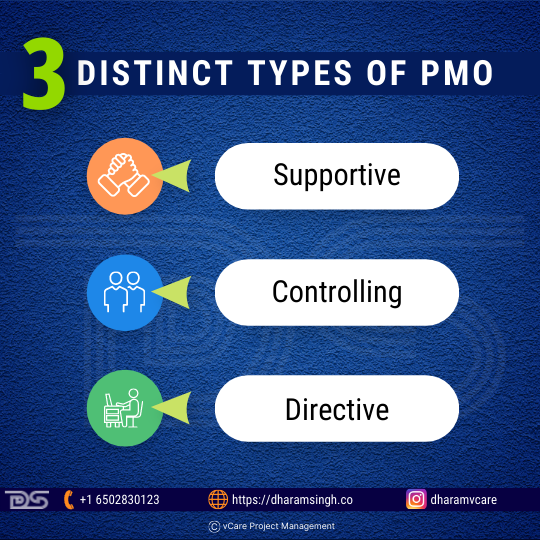
3 Distinct Types of PMO
- Supportive: A supportive PMO gathers all of an organization’s projects and provides best practices, templates, and training but with limited control.
- Controlling: A controlling PMO ensures that project management tools, processes, and standards are implemented in a controlled manner.
- Directive: Within the organization, a directive PMO maintains a high level of control over the project management process.
In 2020 according to the Wellingtone Survey, 89% of organizations reported having at least one PMO.
Role of PMO
Project Office was the term used for aircraft development in the 1930s by the U.S. Air Corps. PMO has been widely adopted since the 1980s when it was first adopted in Construction and IT and slowly adopted in other sectors. It added value and efficiency to the projects and programs through better management. PMO was considered a central administrative office responsible for setting up standard project management methodologies, processes, guidelines, and templates for project teams.
Besides that, PMO extended the arms in training the teams involved in a project about project management practices. Essentially, they imparted knowledge on appropriate project management practices, which helped team members be on the same page on project management practices. They maintained and tracked the lessons learned risks, and project progress, integrated the data between projects, helped share common resources across projects, and ensured project alignment to the business’s strategic objectives. They have been acting more like a center of excellence for Project Management.
Steps to be taken when developing a PMO strategy
- Clarify your company’s goals, vision, and mission.
- Take note of the resources required for a successful operation.
- Choose the best mode of communication.
- Create a system for tracking progress.
- Create a process for resolving conflicts and overcoming project bottlenecks.
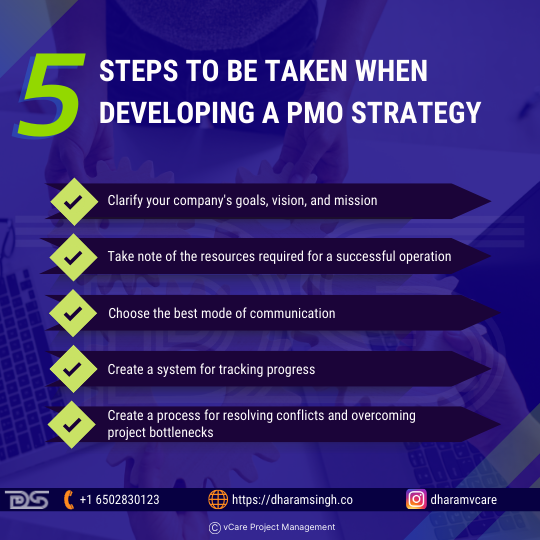
Steps to be taken when developing a PMO strategy
Situation today
In the White Paper: The Future of PMO by Aled Laugharne, Chaucer, states that:
- PMOs operating in the “traditional” way continue to meet stakeholder expectations in around 80% of cases and are considered critical to the program’s success.
- Governance, reporting, planning, and exceptions are all areas where PMOs excel.
- At present, achieving Level 2 – Foundational is sufficient to meet key stakeholder expectations. However, moving to Level 3 – Advanced increases the likelihood of PMOs being marked as “exceeding.”
- Although employers entirely staff some PMOs, consultants and contractors continue to play an important role in PMOs.
- The wider program community is typically less satisfied with PMO performance than key stakeholders who sit centrally.
- In general, there is a 50:50 split between PMOs that believe they need to prioritize improvement and those that want to maintain the status quo or have other program priorities.
Current Potential positive and negative impacts of PMO
The Covid-19 pandemic was the primary driver under External Impacts. However, the consequences of the current crisis appear destined to shape the future of PMO. The following are examples of potential positive and negative consequences:
- Cost-cutting in pandemic-affected industries has resulted in a shift in PMO resourcing to internal staff.
- Change and transformation occur due to the pandemic’s response, increasing the demand for PMO, such as in the Life Sciences industry.
- As a result of virtual working, the need for online collaboration tooling for PMOs is growing.
- With co-location in the country no longer required, virtual working increases global competition for PMO services.
- The rise of Agile PMOs is designed to respond quickly to changing external conditions.
Organizations have started looking to PMOs to optimize the management of increased projects. PMO is responsible for managing delays, cost overruns, quality, and style of the project management practices. Also, they have been involved in resource utilization and accountable for cost-overruns in the projects. It is no more just an administration or supportive role but has become pivotal in strategic and tactical operations across projects.
Today’s PMO in large organizations has an influential role to play. More than being supportive, it has become directive and controlling for compliance and alignment towards organizational objectives. In some organizations, PMOs operate at Strategic Business Unit level or Vertical in alignment with specific sectors with a key focus on Planning, Support, Monitoring, and control functions.
PMO office is involved in providing consistent templates, resources, and tools consistent across projects. Provides an integrated project management capability across the projects and facilitates collaboration in cross-department aspects to align and meet strategic business goals. The tools used and recommended by the PMO are based on Technology, Ease of adoption, price benefit, and ability to scale. Their results directly reflect upon the organization’s operational and resource challenges. Today’s PMO organization helps in who will use the tool, which will maximize benefit, impact on the PMO process, how readiness in terms of adoption, etc.,
Not to mention the problems of meeting deadlines, cost, scope, and quality. There are other areas where PMOs have to evolve; we will discuss some challenges faced by today’s PMOs.
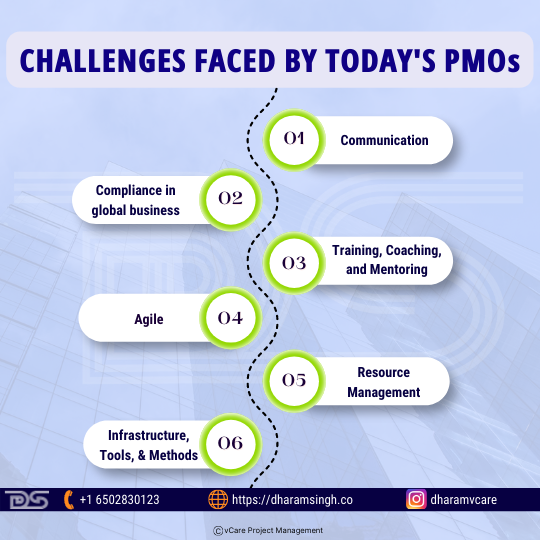
Challenges faced by today’s PMOs
Communication: As an organization has become more digital, the information required by different stakeholders and different levels requires varied contexts. Communication gaps still affect the sponsors or stakeholders due to the availability of information to act on time with the right context. As businesses are so quick to change and environment is dynamic, and priorities change frequently, the PMO must align and adapt quickly.
Compliance in global business: Organizations are no more local. Small or big organizations are starting to have global access thanks to digital. Compliance with organization standards or government regulations when operated across multiple countries. Non-Compliance could turn out to be very costly. Varied and fast changes in procedures/processes would be an additional burden in implementation. Also, cultural factors/time zones would matter when the PMO office is central and not decentralized.
Training, Coaching, and Mentoring: PMOs have to do different things apart from typical training methodologies with project managers/portfolio managers and project associates. When the domain changes, Project managers struggle to cope with these situations. PMO has to help the project manager with an appropriate strategy of training. Ability to track with leading indicators of the training rather than measuring the lagging metrics.
Agile: Large enterprises and organizations are already adopting agile. Requirements are evolving, and project managers don’t have the luxury of having absolute clarity. Yet PMO needs to help the project teams to bring clarity amidst ambiguity, managing assumptions, the definition of done, prioritization, etc. The problem-solving methods have to be made simple and deliver faster decision-making.
Resource Management: Minimizing resource waste is a key function for PMOs, and nowadays, organizations have sustainability goals that will naturally transpire to the PMOs along with project goals. Better planning and coordination are required apart from minimizing risks and managing unforeseen circumstances like COVID. For example, there was a sudden spike for Laptops for resources who are expected to work from home on projects.
Infrastructure, Tools, and Methods: PMO office teams need the right infrastructure in terms of Data, Compute, and more to process data effectively. Current PMO is empowered with tools, predominantly BI and Excel. In the given context of speed of data growth, those tools may not be sufficient. Stronger tools may be required for predictive analytics. Also, the methods are evolving, and the means to collaborate effectively must happen through effective training and other means.
The PMO is evolving into a more strategic role
PMO might focus more on canceling weaker projects. A well-planned project cancellation will free up staff for higher-priority projects. In addition, it makes sense to detect failure early and take appropriate action before the damage worsens. This action contributes to the future cultural shift required for successful project failure.
What holds the future for Tomorrow’s PMO?
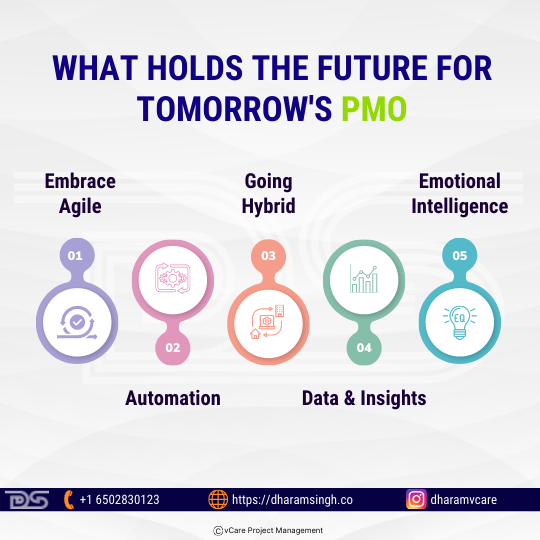
What holds the future for Tomorrow’s PMO
PMO will hold the forte of what matters for the business. They will own the projects and drive results for the organization. In a world where business and IT are more intertwined, the Role of PMO will act as a glue that bonds them together well. PMO will no longer be a support function but will be infused into the business as a core strategy. They will demand that X is needed for Y to be achieved, and this will drive the business objectives and momentum.
Embrace Agile: It has been more than 20+ years since the agile manifesto was released, and the PMO will be more flexible than ever. Organizations are adopting Agile Pods (Product Oriented Delivery) which are a group of small self-organized people with varied skills focused on bringing on the results in development. PMOs will work through this pod and manage the resource pool dynamically based on the project demands with cross-functional awareness. Adopting agile methods by PMOs will result in faster delivery timelines and a more collaborative approach to satisfy stakeholders from a 360-degree perspective. This kind of approach will create a more adaptable PMO function that can be reused and adapted as the PMO function expands its horizons.
Automation: Leverage automation to enhance the speed of delivery. PMOs must identify opportunities for improvement on routine tasks that can be automated. Focus on automating report generation and automation. We need to use the means of notification based on the criticality of the issues to the respective stakeholders. Leverage AI and bots to respond to common queries on the PMO through manual means at enterprise levels. Leveraging automation and AI would help free up critical time for the PMO office to focus on the organization’s strategic goals, act as an enabler to focus on project blockers, and help mobilize resources to resolve bottlenecks in critical paths.
Going Hybrid: By leveraging the tools which can help collaborate better, all the project-related tasks, resources, and people are brought to one place. Teams with varied skills, styles, and different views work together irrespective of place to bring more stability, engagement, and efficiency. Flexible work schedules would also help attract talent and broaden the options which are boundaryless. This freedom also allows the PMO to explore all the options in engaging or onboarding resources required for bringing good results.
Data & Insights: The ability to gain insights from the data is the trend as the data volume is moving from GB to TB. There are heterogeneous data sources beyond organizations that are more external and are to be analyzed through API and SDKs with other systems for meaningful inferences. Data getting converted information and the PMOs responsibility to forecast and identify risks with the knowledge gained through insights will be crucial for the organization. Information insights have to be obtained in less time to act upon it. Integration of communication channels and making it more flexible on push/pull gives the right balance to act upon the information.
Emotional Intelligence: Projects are made of people. People are dealt with emotions daily. Beyond cost, quality and scope, the project managers have to manage the people’s vital resources in the project with care in the times of higher attrition. Striking balance between the millennials and their expectations is crucial, which can be managed through appropriate emotional intelligence management. Managing it would result in handling pressure, making better decisions, strong relationships, and positively impacting the work environment.
Although stakeholders are generally satisfied with current PMO performance, there is a sense that PMOs will need to do the following in the coming years:
- Increase their role in strategic elements of a program, transformation, or organization while decreasing the time spent on transactional processing.
- Increase your tooling and automation, which will allow you to de-scale and facilitate remote working in the “new normal.”
- Organize themselves to quickly “spin up” to support transformations and change the PMO approach as needed.
- Play a bigger role in fusing the “traditional” PMO approach with Agile working methods.
- When establishing and changing the PMO approach, prioritize stakeholder engagement, especially for the larger stakeholder community, and plan specific change activities.
Evolution of PMO – Today & Tomorrow
The PMO’s role might keep changing, but the concept of bridging the gap between today and future PMOs is learning from failures.
- PMOs lose sight of the strategy and become mired in tactical or administrative tasks.
- PMOs maintain a project portfolio that contains gaps, overlaps, and other waste.
- PMOs add processes rather than simplifying or eliminating them.
- PMOs believe that tools will solve all of their problems – or that the flashiest tools will solve all of their problems.
- Even when they provide value, PMOs fail to communicate it.
- PMOs waste too much time on meaningless – or bad – reporting.
- PMOs do not track what is essential or hold people accountable.
- PMOs do not optimize or provide transparency into resource utilization.
- PMOs behave more like police officers than aid workers.
- PMOs either cannot find their place in an agile world or resist it.
As per PMI research, more than 55 percent of PMO directors say the charter for their PMO has changed in the past five years as the impact of technology on PMO is dynamic. The PMO, as part of the organization, is affected by this disruption without exception.
Some examples of the technology used in PMO and its impacts:
- Cloud – 66%
- Digitalization – 54%
- Artificial Intelligence (AI) – 25%
- Internet of Things (IoT) – 24%
- Blockchain – 11%
Conclusion
Transformational PMO needs to learn quickly and must embrace digital disruption. The experts in the domain of PMO have to implement their tools wisely. A new generation of PMOs will be strategic enablers, bridging the gap between a company’s vision and how that vision comes to life. Future PMOs could be virtual or Hybrid. If you are setting up your PMO today, consider all the technical and digital options available on the cloud to use it best. These options would help manage Strategic, Tactical, and operational levels. Include that in your budget. This budgeting would also bring on Collaboration and Transparency. The high use of PPM-Portfolio/Program Management Tools would be crucial for larger organizations. PMO is no more an organization of assigning tasks and monitoring them; it’s well beyond boundaries.
Feel free to check out my discussion on this topic with Thomas Walenta in YouTube.
You can subscribe and follow my podcasts and interviews with Project Management Experts on YouTube at https://bit.ly/2NDY8wd
You can subscribe to vCare Project Management YouTube Channel to catch future videos of our certification Q&A series and student success stories using the link https://bit.ly/2YF0wJl
For any questions related to Project Management career, training, and certifications, you can book an obligation free 15 minutes session with me by visiting talktodharam.com


Recent Comments